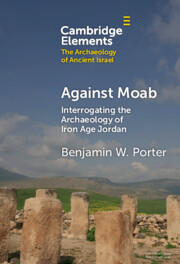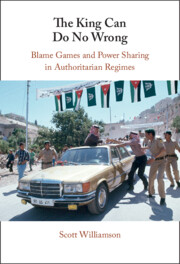Refine search
Actions for selected content:
129 results
5 - Assassinations in Nicosia and Madrid, Attacks in Jordan and Sudan
- from Part II - Europe’s Covert War against the Palestinian Armed Struggle
-
- Book:
- Operation Wrath of God
- Published online:
- 12 August 2025
- Print publication:
- 07 August 2025, pp 111-147
-
- Chapter
- Export citation
5 - “The Minister of Victory”
-
- Book:
- Moshe Dayan
- Published online:
- 03 April 2025
- Print publication:
- 10 April 2025, pp 194-236
-
- Chapter
- Export citation
3 - Generalship
-
- Book:
- Moshe Dayan
- Published online:
- 03 April 2025
- Print publication:
- 10 April 2025, pp 90-135
-
- Chapter
- Export citation

Against Moab
- Interrogating the Archaeology of Iron Age Jordan
-
- Published online:
- 14 March 2025
- Print publication:
- 10 April 2025
-
- Element
-
- You have access
- Open access
- HTML
- Export citation
Crisis-prompted online language teaching: a qualitative inquiry into autonomy among teachers in refugee settings
-
- Article
-
- You have access
- Open access
- HTML
- Export citation
7 - How Jordan’s Blame Games Influence Governance
-
- Book:
- The King Can Do No Wrong
- Published online:
- 21 November 2024
- Print publication:
- 28 November 2024, pp 213-235
-
- Chapter
- Export citation
5 - How Jordanians Attribute Responsibility
-
- Book:
- The King Can Do No Wrong
- Published online:
- 21 November 2024
- Print publication:
- 28 November 2024, pp 146-172
-
- Chapter
- Export citation
6 - Power Sharing and Attributions across Jordan’s Modern History
-
- Book:
- The King Can Do No Wrong
- Published online:
- 21 November 2024
- Print publication:
- 28 November 2024, pp 173-212
-
- Chapter
- Export citation
4 - The Jordanian Monarchy’s Strategic Blame Games
-
- Book:
- The King Can Do No Wrong
- Published online:
- 21 November 2024
- Print publication:
- 28 November 2024, pp 114-145
-
- Chapter
- Export citation

The King Can Do No Wrong
- Blame Games and Power Sharing in Authoritarian Regimes
-
- Published online:
- 21 November 2024
- Print publication:
- 28 November 2024
Citizenship in the shadow of law: identifying the origins, effects, and operation of legal ambiguity in Jordan
-
- Journal:
- Law & Society Review / Volume 58 / Issue 4 / December 2024
- Published online by Cambridge University Press:
- 14 November 2024, pp. 573-606
- Print publication:
- December 2024
-
- Article
-
- You have access
- Open access
- HTML
- Export citation
Ferrodimolybdenite, FeMo3+2S4 from Daba-Siwaqa, Jordan – the first natural compound of trivalent molybdenum
-
- Journal:
- Mineralogical Magazine / Volume 89 / Issue 2 / April 2025
- Published online by Cambridge University Press:
- 11 November 2024, pp. 242-249
-
- Article
-
- You have access
- Open access
- HTML
- Export citation
Psychological well-being, food insecurity, academic performance and other risk factors in a sample of university students in Jordan during COVID-19
-
- Journal:
- Journal of Nutritional Science / Volume 13 / 2024
- Published online by Cambridge University Press:
- 10 October 2024, e61
-
- Article
-
- You have access
- Open access
- HTML
- Export citation
A multiscalar approach to survey of military and trade architecture in Jordan: the case of Khirbet al-Khalde
-
- Article
-
- You have access
- Open access
- HTML
- Export citation
Jordanian Nurses’ Perceptions of Disaster Preparedness and Core Competencies
-
- Journal:
- Disaster Medicine and Public Health Preparedness / Volume 18 / 2024
- Published online by Cambridge University Press:
- 24 April 2024, e96
-
- Article
-
- You have access
- Open access
- HTML
- Export citation
Nurturing families: A feasibility randomised controlled trial of a whole-family intervention with vulnerable families in Jordan
-
- Journal:
- Cambridge Prisms: Global Mental Health / Volume 11 / 2024
- Published online by Cambridge University Press:
- 11 April 2024, e51
-
- Article
-
- You have access
- Open access
- HTML
- Export citation
The History of the Development of Clay Mineralogy
-
- Journal:
- Clays and Clay Minerals / Volume 36 / Issue 2 / April 1988
- Published online by Cambridge University Press:
- 02 April 2024, pp. 97-101
-
- Article
- Export citation
The Rule-of-Law as a Problem Space: Wāsṭa and the Paradox of Justice in Jordan
-
- Journal:
- Comparative Studies in Society and History / Volume 66 / Issue 1 / January 2024
- Published online by Cambridge University Press:
- 24 October 2023, pp. 131-154
-
- Article
-
- You have access
- Open access
- HTML
- Export citation
Deynekoite, Ca9□Fe3+(PO4)7 – a new mineral of the merrillite group from phosphide-bearing contact facies of paralava, Hatrurim Complex, Daba-Siwaqa, Jordan
-
- Journal:
- Mineralogical Magazine / Volume 87 / Issue 6 / December 2023
- Published online by Cambridge University Press:
- 11 September 2023, pp. 943-954
-
- Article
- Export citation
5 - Crony Capitalism in International Comparison
-
- Book:
- Making Democracy Safe for Busines
- Published online:
- 22 June 2023
- Print publication:
- 06 July 2023, pp 148-168
-
- Chapter
- Export citation
